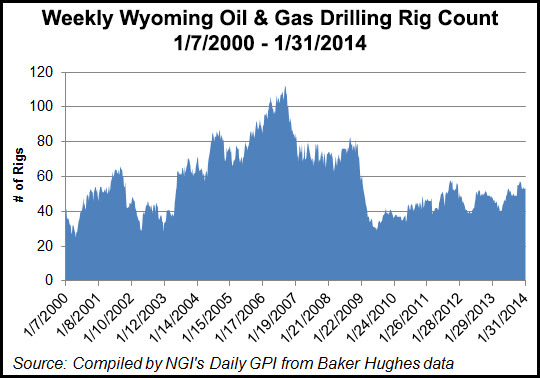Regulatory | NGI All News Access
Governor, Enviros Eye Wyoming Well Plugging Effort
In the face of the current robust oil and natural gas exploration/production (E&P) work in natural resource-rich states like Wyoming, the Environmental Defense Fund (EDF) is prodding states to prepare for an inevitable downturn. EDF contends that in past boom-bust periods, operators abandoned many wells without properly capping and closing them.

EDF reminded Wyoming officials again on Friday that when “the bottom falls out on commodity prices., [historically] it has been too easy for operators to declare bankruptcy and walk away — sticking taxpayers with the tab for plugging and remediation.”
That’s not supposed to happen in Wyoming, where Gov. Matt Mead late last year unveiled a four-year plan to accelerate the plugging of more than 1,200 abandoned oil and natural gas wells on state and fee lands (see Daily GPI, Dec. 11, 2013). The move to accelerate efforts to complete well plugging is still awaiting action by the state legislature and involves several state agencies, including the Oil and Gas Conservation Commission (OGCC), Department of Environmental Quality, Office of State Lands and the State Engineer.
“The legislature asked for a program, and there is a proposal and $3 million spending item that [the lawmakers] need to work on when they start their session Feb. 10,” said Mead spokesperson Renny MacKay. In the meantime, there has been advance work between state and federal agencies, MacKay said.
The funding comes from monies paid to the state by oil and gas producers and does not come from the state’s general budget, he said. EDF has estimated that the full cost of dealing with the problem could approach $32 million.
“To its credit, the Petroleum Association of Wyoming has come forward in support of raising the conservation tax and using those funds to help plug orphan wells,” an EDF spokesperson said.
With estimates that the state’s total of orphan wells could climb to 5,700 as an outgrowth of a boom-bust in coal-bed methane, Mead’s plan would set an initial $3 million to begin addressing the problems, whose level of severity varies with each stakeholder in the state.
EDF has called Mead’s plan a good first step, offering a prioritized four-year schedule for proper plugging, identifying and resolving data gaps in the OGCC and the federal Bureau of Land Management making accounting for orphan wells very difficult, and reviewing producers’ bonding levels to properly plug wells.
“The governor’s proposal is a good, aggressive first step toward addressing Wyoming’s orphan well problem, and with some key improvements advocated by EDF and the Wyoming Outdoor Council, this effort could become a model for other states and similar problem,” the EDF spokesperson said.
There were 53 natural gas and oil rigs operating in the state last week, and that number has remained between 49 and 57 since the end of June, according to Baker Hughes data. That’s a far cry from the 112 rigs that were operating in the state in September, 2006.
© 2024 Natural Gas Intelligence. All rights reserved.
ISSN © 1532-1231 | ISSN © 2577-9877 |
